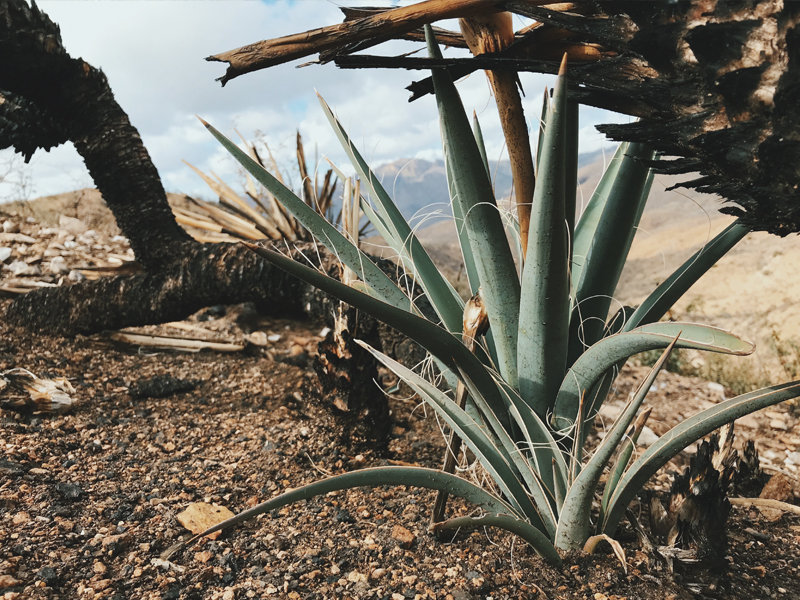This month’s EcoQuest is dedicated to learning more about Sonoran Desert plants that can survive or repopulate after fire. Observing these plants can help teach how to recognize them and increase our appreciation and understanding of the Sonoran Desert ecosystem.
Join the EcoQuest here: https://www.inaturalist.org/projects/sonoran-survivors
This wildfire season is already off to a very hot start, with multiple fires very close to urban areas. Understanding more about wildfire and the Sonoran Desert can help raise awareness about wildfire impacts and how to attempt restoration. If you have experienced fire where you live, the plants in this month’s EcoQuest can help facilitate recovery of the desert landscape. Mapping these plants close to home can also provide information on what species could naturally make a comeback in your area.
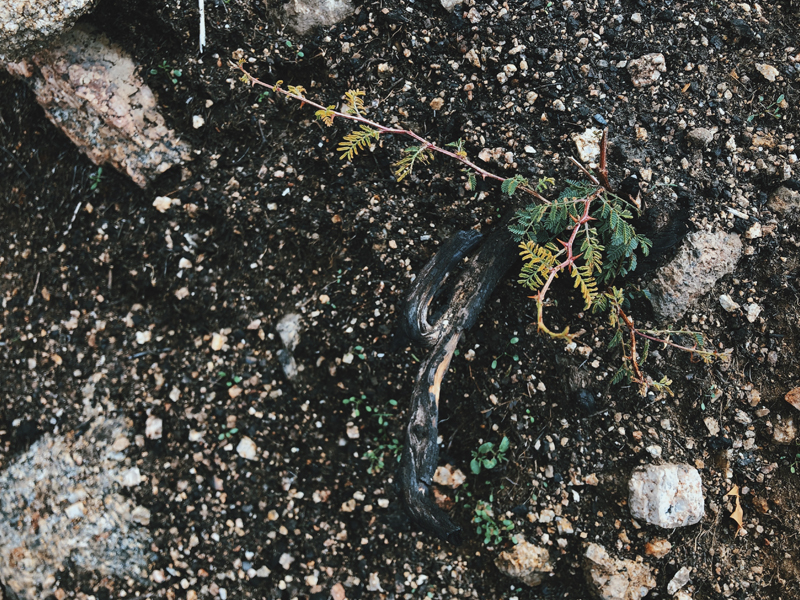
Fire-adapted ecosystems are those that experience a regular occurrence of fire, and it mostly benefits the ecosystem. Plants that are fire adapted have traits that help them survive, recover or reproduce after wildfire. Examples of this include seed that relies on heat from fire to help them germinate, thick bark that protects a tree form fire damage, or plants that can resprout from their roots after the top part of the plant has burned away. To the best of knowledge, natural fires have not historically been a significant part of the Sonoran Desert. Unlike fire-adapted ecosystems, most of the plant life in the desert is not built to withstand intense, large-scale wildfires. Compounding factors such as climate change, invasive species, and a rise in outdoor recreation have contributed to an increase in major fires here in the Sonoran Desert. These larger, and often hotter fires that are happening closer together in time, do not play well with desert plants that are not adapted for it. This includes iconic cactus like saguaro and prickly pear, as well as agaves, and the desert’s rare plants, which may find it even more difficult to recover on a species level.
Some fires may have naturally occurred in the past, but the spacing of plants in the desert had prevented wildfire from spreading and having an extensive impact. More recently, successive wet winters combined with hotter, drier summers have contributed to an increase of annual dried vegetation, creating a perfect storm of biomass fuel for wildfires. Humans have also altered the natural landscape with the introduction of nonnative species. Many of these species have become “invasive” especially grasses (such as red brome (Bromus rubens), Mediterranean grass (Schismus barbatus.), fountain grass (Pennisetum setaceum), and buffelgrass (Cenchrus ciliaris)) and stinknet (Oncosiphon piluliferum). Invasive plants are capable of rapid reproduction and displacement of native plants through competition for space and resources. They are most often introduced to the landscape and do not have the natural constraints of where they naturally grow to keep their populations in check. These plants can dominate the desert landscape and are filling in the open space that historically existed between desert plants. Now, when a fire starts in the Sonoran Desert, instead of burning a small patch of vegetation and then burning out, the fire can “run” because all of these plant patches are interwoven in a fabric of invasive species and increased annual vegetation growth.

Many Sonoran Desert trees and shrubs also support that the Sonoran Desert is not fire adapted. Brittlebush (Encelia farinosa) and triangle-leaf bursage (Ambrosia deltoidea) are most often reduced to ash, eventually making a comeback thanks to seed from other areas. Foothills palo verde (Parkinsonia microphylla) and ocotillo (Foquieria splendens) can be completely eliminated by fire, and have been reported to not return in some burned areas. Even a fire that is considered low or medium intensity can be detrimental for foothills palo verde (Parkinsonia microphylla). Their bark is very thin, and they use it for photosynthesis (hence the green color). If they are not killed by fire outright, searing from flames or heat can take that photosynthetic ability away, and/or damage the inner layers of the tree, leading to eventual death. Although plants like jojoba (Simmondsia chinensis) or creosote (Larrea tridentata) can possibly resprout, that does not mean they will. The ones that do are likely to be less healthy and not live as long. The plants that seem to handle fire the best and resprout vigorously, such as fairy duster (Calliandra eriophylla) and catclaw (Senegalia greggii), are often those that are also found outside of the Sonoran Desert in areas that are fire adapted.
Sonoran Desert agaves and cactus also point to the desert not having evolved with larger, hotter fires. Both groups of plants have evolved multiple effective adaptations for the desert’s natural heat and drought, but have not evolved the adaptations associated with a fire regime. Cactus and agave both use a unique photosynthetic process known as CAM (Crassulacean acid metabolism). Plants take in carbon dioxide through holes in their leaves called stomata. Unlike most plants, cactus and agaves open their stomata in the cooler night, taking in and storing carbon dioxide until the sun comes out. This allows these plants to not lose as much moisture, as opposed to having open stomata during the heat of the day. Both cactus and agaves also exhibit succulence, a characteristic that allows them to store extra water in their body tissues. Neither of these water-saving techniques acquired through evolutionary time protect them from fire, however. Cactus specifically are almost always killed outright by fire.
Specifically concerning saguaros (Carnegiea gigantea), if they are not initially killed by fire, most succumb to moderate or severe fire injury within the next decade or sooner. Saguaro seedlings and young plants are lost. It can take a decade for these icons to reach one inch in height, 50 to 60 years to reach about 6 feet, and 90 to 100 years to reach about 15 feet. The time scale at which saguaro grow is in itself, evidence that fire has not been significant in their habitat.
Agaves’ specific heat and drought adaptations include a rosette shape that funnels rain to their roots and shades the plant, leaf surfaces covered with a waxy coating to prevent water loss from stomata in extreme temperatures, gray-green leaves to maximize reflection of sunlight and keep the plant cool, and more. These traits, too, do not protect agaves from fire. Some agaves, such as Parry’s agave (Agave parryi), may be able to survive lower intensity fire if they’ve produced several “pups” (clonal ramets) from their underground stems – the stems within that clone may survive if the low intensity fire doesn’t burn the entire clone.
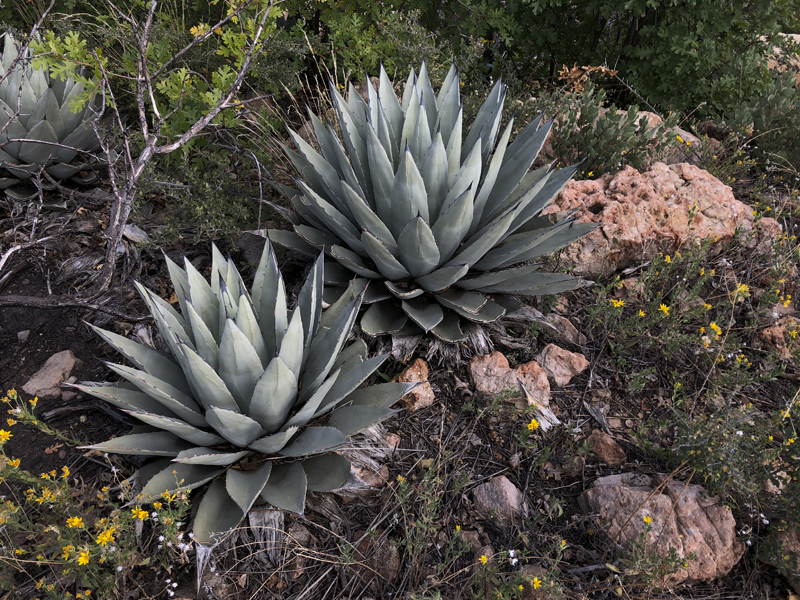
Having evolved complex heat and drought resisting features, but no real resistance to fire or an ability to survive it, points to the absence of fire as an ecological and evolutionary process in these Sonoran Desert plants’ ecosystem.
Recovery in the Sonoran Desert is not a fast process. Many plants have very specific conditions for seed germination, and growth is often painfully slow. It could take multiple human generations after a fire for saguaros to regain the widespread majesty of a forest, if they can. Sonoran Desert that has been severely impacted by fire has the potential to shift to a very different landscape than what we know now, especially with repeated incidence of fire.
————————————————————-
The following is a list of some Sonoran Desert plants that can possibly recover/resprout, plants that can reestablish themselves by seed, and plants that can be planted to help create the right conditions for other plants to begin to grow after a fire.
To see photos of these plants and to learn more about them, please visit the Sonoran Desert Wildfire Plants guide. This is especially helpful for those looking to restore their home landscape after a wildfire.
You can find the guide here:
https://www.inaturalist.org/guides/11983
For a list of local nurseries that offer a variety of native plants and/or seed:
https://aznps.com/wp-content/uploads/AZNPS-PHX-retail-nurseries-list-Mar2019
Plants that can resprout:
Fairy Duster (Calliandra eriophylla)
Mormon Tea (Ephedra spp.)
White Rattany (Krameria bicolor)
Jojoba (Simmondsia chinensis)
Catclaw (Senegalia greggii)
Whitethorn Acacia Vachellia constricta
Banana yucca (Yucca baccata)
Creosote (Larrea tridentata)*
Ironwood (Olneya tesota)*
*not as likely to resprout
Plants that can naturally reestablish from seed:
Wire lettuce (Stephanomeria spp.)
Desert Broom (Baccharis sarothroides)
Snakeweed (Gutierrezia sarothrae)
Globe Mallow (Sphaeralcea spp.)
Brittlebush (Encelia farinosa)
Triangle-Leaf Bursage (Ambrosia deltoidea)
Recommended for planting:
Brittlebush (Encelia farinosa)*
Triangle-Leaf Bursage (Ambrosia deltoidea)*
Engelmann’s Prickly Pear (Opuntia engelmanni)i**
Brown-spined Prickly Pear (Opuntia phaeacantha)**
Buckhorn Cholla (Cylindropuntia acanthocarpa)**
Jumping Cholla (Cylindropuntia fulgida fulgida)**
Boxing Glove Cactus (Cylindropuntia fulgida mammillata)**
Saguaro (Carnegia gigantea)***
Graham’s Fishhook Cactus (Mammillaria grahamii)***
California Barrell Cactus (Ferocactus cylindraceus)***
Engelmann’s Hedgehog Cactus (Echinocereus engelmannii)***
*These are highly recommended because they are considered “nurse plants.” They provide shelter and a favorable place for young seedlings and plants to grow.
**If these cactus are not severely scorched, they can be grown from healthy pieces/paddles. 18-20 inch stems are recommended.
***Plant new, full plants
It is NOT recommended to remove charred plants or soil. Disturbing the soil makes it much easier for invasive species to move in and dominate, and native plant seed may be unintentionally removed in the process. This can also worsen erosion impacts. If plants must be removed for safety reasons, try to leave the roots in tact.
To help protect young plants from hungry animals, you can surround them with a ½” mesh galvanized hardware cloth cage.
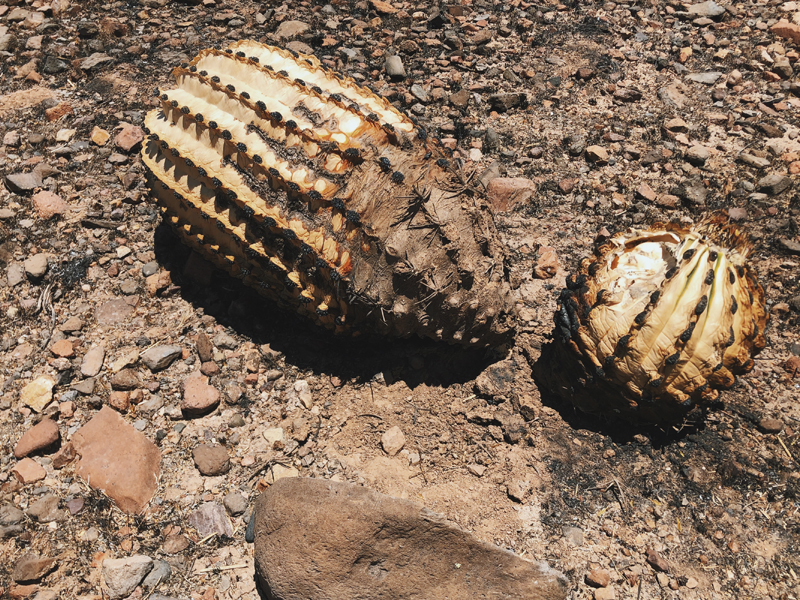
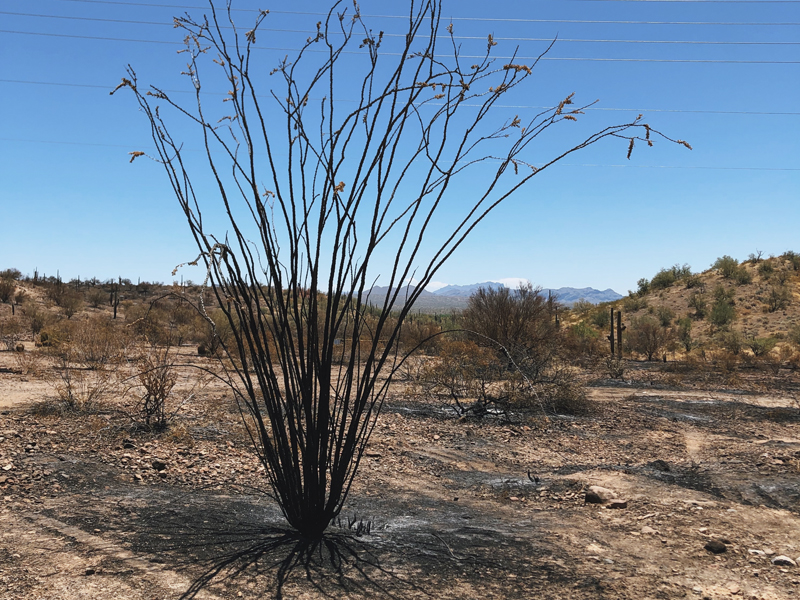
Unfortunately, as mentioned above, cactus, trees, and Ocotillo (Foquieria splendens) do not fare well with intense fire. Foothills Palo Verde (Parkinsonia microphylla) and Ironwood (Olneya tesota) may survive if they are not overly scorched. The best thing to do for plants that do not survive is to plant new vegetation that provides shelter and habitat for them to germinate and grow naturally.
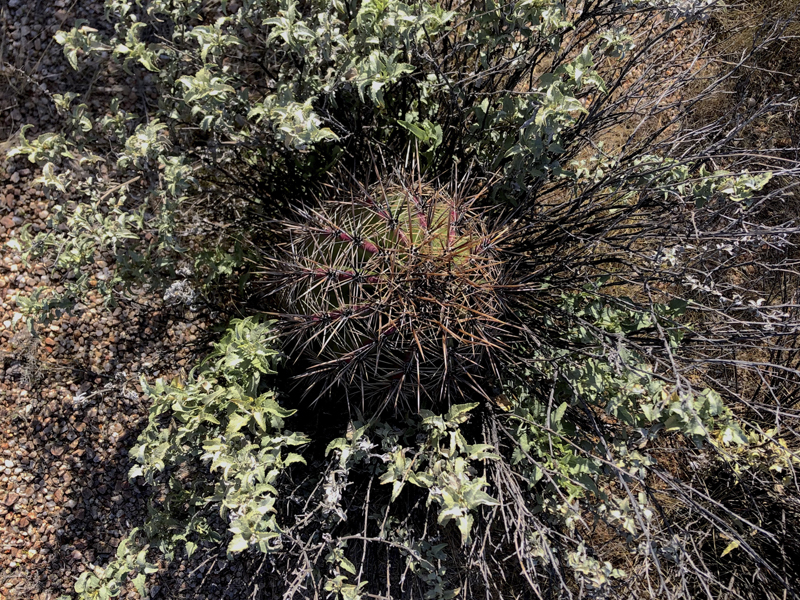
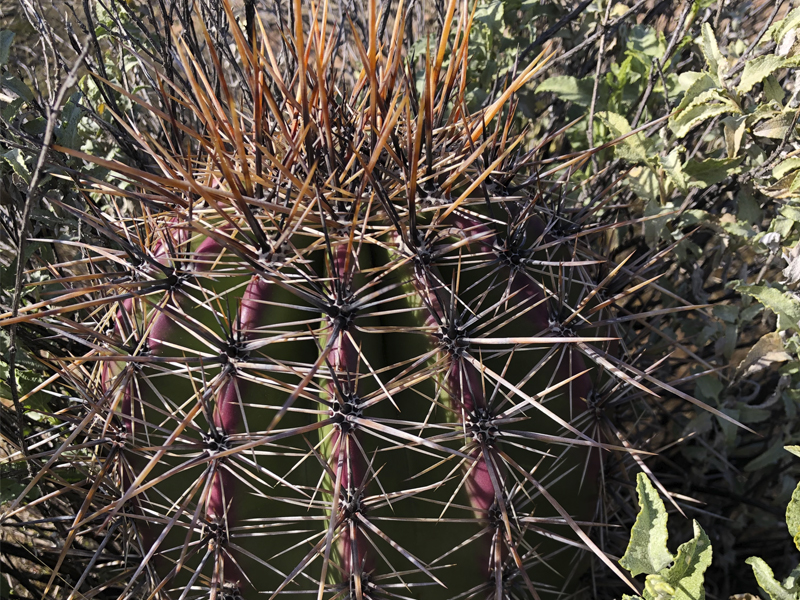
According to the National Interagency Fire Center, in 2019, 87% of wildfires were caused by people.
How you can help prevent wildfires in the desert:
If you see something say something. Do not assume it has already been reported. Contact your local fire department, the park service or 911.
Keep a shovel, extra water and a fire extinguisher on hand, especially in your vehicle or ATV.
Do not drive in or park on dry grass or brush. Your car is hot enough to start a fire.
Shoot targets in areas free of dry vegetation, and do not shoot on hot, windy days.
Learn how to properly extinguish campfires.
Do not throw lit cigarettes or butts out the window or onto the trail.
Fireworks and explosives are illegal on public lands.
Check trailer chains, these can spark and start a fire.
Learn more here:
https://wildlandfire.az.gov/prevention-news
https://www.readyforwildfire.org/prevent-wildfire/target-shooting-safety/
For more information on these plants, what you can do for after a wildfire, or other questions, please email [email protected].
————————————————————-
Sources:
Dr. Joe McAuliffe, Dept. of Research, Conservation & Collections, Desert Botanical Garden
Raul Puente-Martinez, Dept. of Research, Conservation & Collections, Desert Botanical Garden
Wendy Hodgson, Dept. of Research, Conservation & Collections, Desert Botanical Garden
Lane Butler, Dept. of Research, Conservation & Collections, Desert Botanical Garden
Juanita Armstrong, Natural Resource Specialist, Maricopa County Parks and Recreation
R.C. Wilson, M.G. Narog, A.L. Koonce, and B.M. Cocoran, https://www.fs.fed.us/psw/publications/4403/PostfireRegen.pdf
————————————————————-
EcoQuests are month-long challenges that are part of the larger Metro Phoenix EcoFlora project.
You can learn more and join the Metro Phoenix EcoFlora here:
https://www.inaturalist.org/projects/metro-phoenix-ecoflora
Sign up for the newsletter at [email protected].
**PLEASE observe COVID-19 guidelines/recommendations.**
This a great opportunity to get outdoors close to home as we all navigate the complications of COVID-19. However, it is imperative that you follow the guidelines/recommendations of your local governments and institutions (wear a mask, practice physical distancing and wash your hands). Do what’s best for you and your community.
Arizona Office of Tourism: Responsible Recreation in AZ
https://tourism.az.gov/responsible-recreation-across-arizona
NO TRESSPASSING
Do not remove or move natural materials (plants, animals, rocks)
Respect wildlife (do not touch, feed, or disturb animals)
